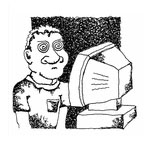
A Perfect Media Maelstrom
VIRTUAL TORNADO LEAVES 160 DEAD
Electronic distraction keeps reaching new milestones. Johnny might not be able to read, but he has mastered Grand Theft Auto. Thousands of young gadget aficionados are prescribed Adderall or Ritalin to counteract the symptoms of excess screen time. Thousands more die or are injured each year because someone at the controls of a car, bus, or ship succumbs to the same digital compulsion. Last but not least, an entire city looks the other way during its tornadic obliteration.
You won’t find this last item mentioned in the media. For one thing, it happened over a decade ago — ancient history in today’s news cycle. For another, media may have exacerbated the calamity, which helps explain the delay in this reportage. With apologies to media theorist Marshall McLuhan, the medium in this case may have been an accessory to manslaughter.
Before trying to decipher what it all means, let’s return to the scene of an old, unsolved mystery. To paraphrase an old saw, those who don’t know recent history are doomed to recycle it.
On the evening of May 22, 2011, my brother called me from Kansas City on a landline telephone. “Did you hear,” Mark asked, “that a tornado just wiped Joplin off the map?”
Mark and I know something about what it is to have your city, or at least large sections of it, sucked away. Topeka, our hometown, was hit in 1966 by a twister so monumental that the damage in monetary terms surpassed that of any previous tornado. Legend has it that the storm was conjured by the ghosts of Potawatomi Indians angry at city fathers who had capped their tribe’s ancestral burial mound with a water tank. The tornado made its retaliatory appearance directly over the top of the mound.
You May Also Enjoy
In Catholic worship, the truth of God and man is revealed. The revelation takes root in only those who harmonize themselves within the hierarchy of God and man.
Every technological development, at least up until now, has created a new tool that can be pressed into the service (or disservice) of man.
The ultimate pitfall of classical liberalism is the annihilation of morality and the destruction of meaningful community life.

